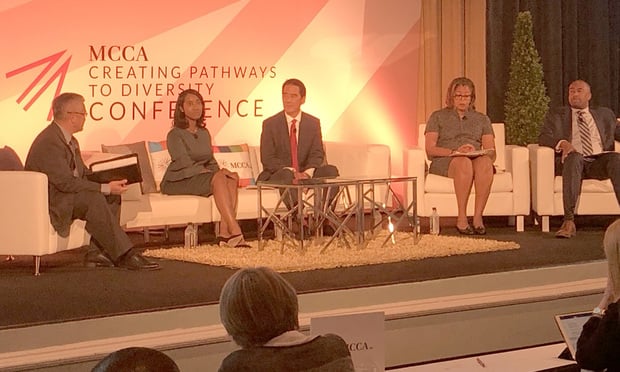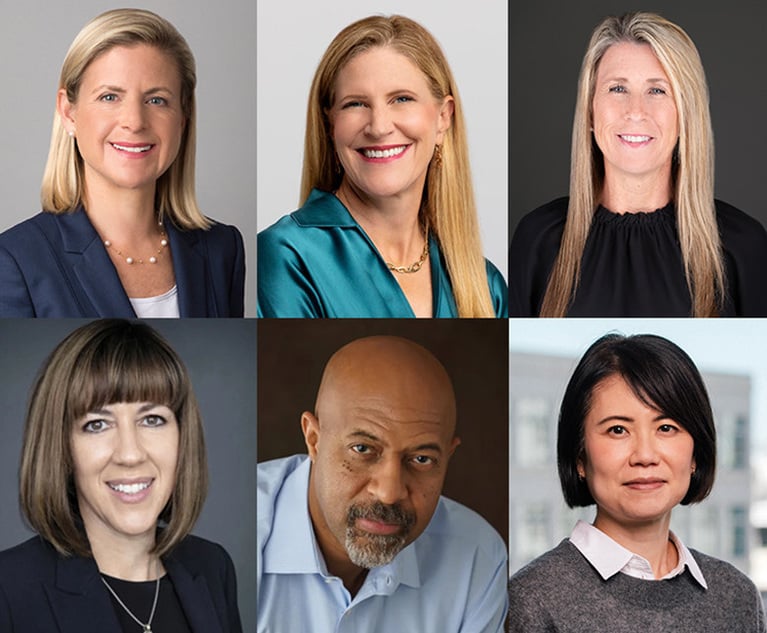Panel: Becoming a Chief Diversity Officer Comes With Unexpected Challenges
Becoming a chief diversity officer at a major corporation or a law firm requires more than just a passion for equality and coming up with diversity and inclusion policies, a panel at the Minority Corporate Counsel Association's 2019 Creating Pathways to Diversity Conference in New York said Monday.
October 14, 2019 at 05:18 PM
4 minute read
 Kevin R. Lyn, a partner and diversity chairman at Womble Bond Dickinson; Erica Bolden, head of diversity and inclusion at Mercedes-Benz, USA; John Iino, a partner and global chief diversity officer at Reed Smith; Melique Jones, director of talent pipeline and diversity and inclusion at Skadden, Arps, Slate, Meagher & Flom; and Peter Wilson Jr., diversity and inclusion officer at Proskauer Rose, at the Minority Corporate Counsel Association's Creating Pathways to Diversity Conference in New York. (Courtesy photo)
Kevin R. Lyn, a partner and diversity chairman at Womble Bond Dickinson; Erica Bolden, head of diversity and inclusion at Mercedes-Benz, USA; John Iino, a partner and global chief diversity officer at Reed Smith; Melique Jones, director of talent pipeline and diversity and inclusion at Skadden, Arps, Slate, Meagher & Flom; and Peter Wilson Jr., diversity and inclusion officer at Proskauer Rose, at the Minority Corporate Counsel Association's Creating Pathways to Diversity Conference in New York. (Courtesy photo)
Becoming a chief diversity officer at a major corporation or a law firm requires more than just a passion for equality and coming up with diversity and inclusion policies, a panel at the Minority Corporate Counsel Association's 2019 Creating Pathways to Diversity Conference in New York said Monday.
Peter Wilson Jr., now diversity and inclusion officer at Proskauer Rose in New York, said when he was first put in charge of diversity and inclusion at another firm, he did not foresee he would have to become so involved with the associates.
"There are not enough soldiers out here willing to do the work," Wilson said. "In order to make sure I was moving the needle in some meaningful way, I had to get involved in all aspects of associate life. Hours, reports. Who are they working with? What level of progression are they having in their careers?"
Starting out, Wilson knew many law firms did not succeed in going into uncharted territory. He said he had to get partners to practice D&I to achieve better business results, which often meant trying the untested.
"In the space of D&I, you have got to be willing to go out on a limb and try new things," Wilson said. "My first major challenge was trying to convince people that being different and setting yourself apart in the legal industry was [not only] valuable but was, in fact, the best way for us to make a real impact."
Melique Jones, director of the talent pipeline and diversity and inclusion at Skadden, Arps, Slate, Meagher & Flom in New York, said one of her challenges was helping people understand that even in an organization with good intentions, they were still the product of a society that carried around a lot of "baggage."
"For me, in the beginning, it was a lot of conversations with associates and testing what associates felt was missing," Jones said. "In the first instance, we asked, 'How are you experiencing this place and this environment?'"
John Iino, a partner and global chief diversity officer at Reed Smith in Los Angeles, said this year the firm conducted an inclusion survey sent out to all personnel. He said that was a signal to all employees that inclusion matters and lets executives and partners know where they can do more.
For a diversity and inclusion program to survive budget cuts, Iino said it must be engrained throughout a company's entire organization. "Make your function invaluable and make it embedded in all aspects of the business."
This content has been archived. It is available through our partners, LexisNexis® and Bloomberg Law.
To view this content, please continue to their sites.
Not a Lexis Subscriber?
Subscribe Now
Not a Bloomberg Law Subscriber?
Subscribe Now
NOT FOR REPRINT
© 2025 ALM Global, LLC, All Rights Reserved. Request academic re-use from www.copyright.com. All other uses, submit a request to [email protected]. For more information visit Asset & Logo Licensing.
You Might Like
View All
Exits Leave American Airlines, SiriusXM, Spotify Searching for New Legal Chiefs
2 minute read


After Botched Landing of United Airlines Boeing 767, Unlikely Plaintiff Sues Carrier
5 minute readTrending Stories
- 1Uber Files RICO Suit Against Plaintiff-Side Firms Alleging Fraudulent Injury Claims
- 2The Law Firm Disrupted: Scrutinizing the Elephant More Than the Mouse
- 3Inherent Diminished Value Damages Unavailable to 3rd-Party Claimants, Court Says
- 4Pa. Defense Firm Sued by Client Over Ex-Eagles Player's $43.5M Med Mal Win
- 5Losses Mount at Morris Manning, but Departing Ex-Chair Stays Bullish About His Old Firm's Future
Who Got The Work
J. Brugh Lower of Gibbons has entered an appearance for industrial equipment supplier Devco Corporation in a pending trademark infringement lawsuit. The suit, accusing the defendant of selling knock-off Graco products, was filed Dec. 18 in New Jersey District Court by Rivkin Radler on behalf of Graco Inc. and Graco Minnesota. The case, assigned to U.S. District Judge Zahid N. Quraishi, is 3:24-cv-11294, Graco Inc. et al v. Devco Corporation.
Who Got The Work
Rebecca Maller-Stein and Kent A. Yalowitz of Arnold & Porter Kaye Scholer have entered their appearances for Hanaco Venture Capital and its executives, Lior Prosor and David Frankel, in a pending securities lawsuit. The action, filed on Dec. 24 in New York Southern District Court by Zell, Aron & Co. on behalf of Goldeneye Advisors, accuses the defendants of negligently and fraudulently managing the plaintiff's $1 million investment. The case, assigned to U.S. District Judge Vernon S. Broderick, is 1:24-cv-09918, Goldeneye Advisors, LLC v. Hanaco Venture Capital, Ltd. et al.
Who Got The Work
Attorneys from A&O Shearman has stepped in as defense counsel for Toronto-Dominion Bank and other defendants in a pending securities class action. The suit, filed Dec. 11 in New York Southern District Court by Bleichmar Fonti & Auld, accuses the defendants of concealing the bank's 'pervasive' deficiencies in regards to its compliance with the Bank Secrecy Act and the quality of its anti-money laundering controls. The case, assigned to U.S. District Judge Arun Subramanian, is 1:24-cv-09445, Gonzalez v. The Toronto-Dominion Bank et al.
Who Got The Work
Crown Castle International, a Pennsylvania company providing shared communications infrastructure, has turned to Luke D. Wolf of Gordon Rees Scully Mansukhani to fend off a pending breach-of-contract lawsuit. The court action, filed Nov. 25 in Michigan Eastern District Court by Hooper Hathaway PC on behalf of The Town Residences LLC, accuses Crown Castle of failing to transfer approximately $30,000 in utility payments from T-Mobile in breach of a roof-top lease and assignment agreement. The case, assigned to U.S. District Judge Susan K. Declercq, is 2:24-cv-13131, The Town Residences LLC v. T-Mobile US, Inc. et al.
Who Got The Work
Wilfred P. Coronato and Daniel M. Schwartz of McCarter & English have stepped in as defense counsel to Electrolux Home Products Inc. in a pending product liability lawsuit. The court action, filed Nov. 26 in New York Eastern District Court by Poulos Lopiccolo PC and Nagel Rice LLP on behalf of David Stern, alleges that the defendant's refrigerators’ drawers and shelving repeatedly break and fall apart within months after purchase. The case, assigned to U.S. District Judge Joan M. Azrack, is 2:24-cv-08204, Stern v. Electrolux Home Products, Inc.
Featured Firms
Law Offices of Gary Martin Hays & Associates, P.C.
(470) 294-1674
Law Offices of Mark E. Salomone
(857) 444-6468
Smith & Hassler
(713) 739-1250






